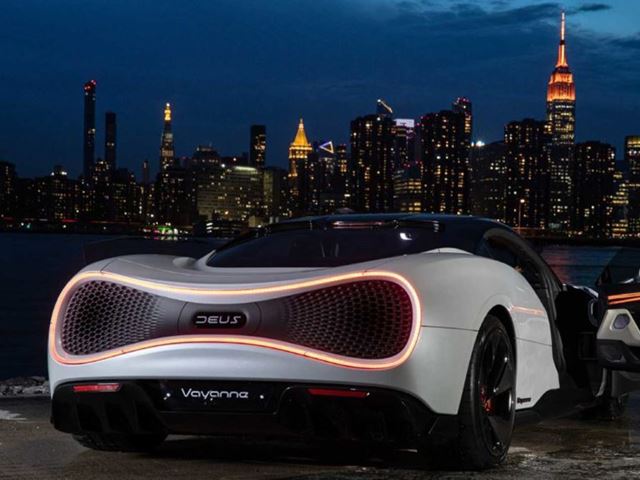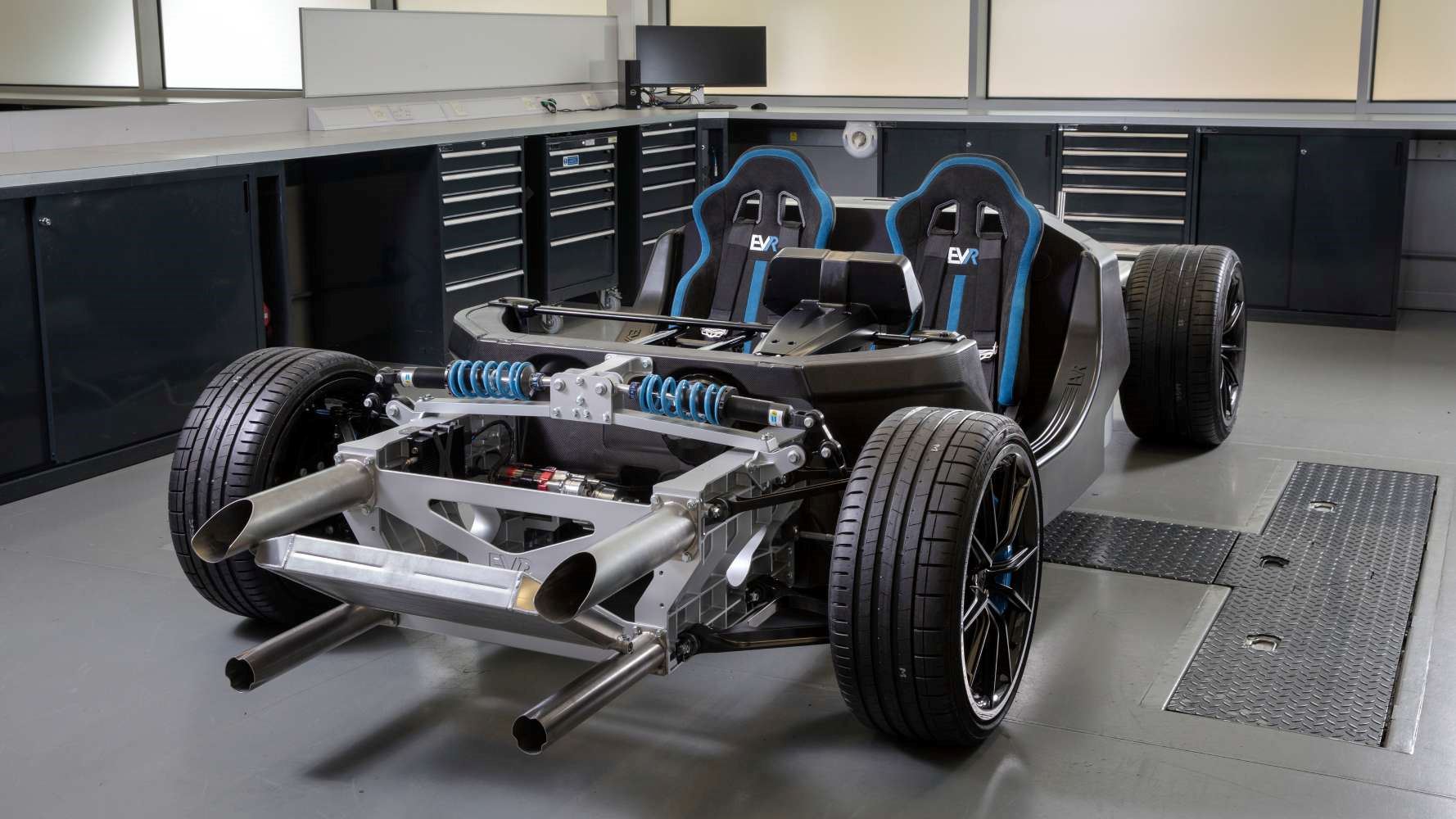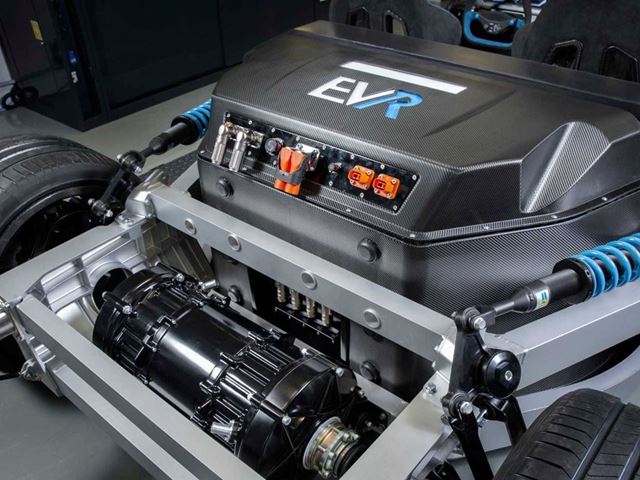
- Latest: Welcome to Auto Futures - Mobility News, Features, Exclusives and More...
- Latest: Mercedes-Benz Unveils the SUSTAINEER - an Electric Last-Mile Delivery Solution
- Latest: XPENG & Volkswagen to Jointly Develop Electrical/Electronic Architecture in China
- Latest: Honda Unveils Ye - its Next-Generation EV Series for China
- Latest: JLR Launches Portable Battery Energy Storage System Using 2nd-Life PHEV Batteries
- Latest: The US Startup Rolling out Urban Curbside EV Charging - Voltpost's CEO
Is Williams Advanced Engineering's Electric EVR Platform for Supercar Success?

"10 years ago, people were very doubtful whether electric vehicles would ever be that engaging or could really compete with V8 or V12 combustion engines," says Chris McCaw, Lead Engineer of Vehicle Integration at Williams Advanced Engineering (WAE).
"I think the launches of vehicles in the last three years and having gone through the development process have clearly shown that they are equally comparable with those vehicles."
We're talking to McCaw over the phone, he is currently at LCV Cenex, a British trade show focused on electric and fuel cell vehicles. Ten years ago, the thought of revealing a vehicle platform capable of putting 1,650 kW (around 2,200 horsepower in old money) to the road at a show like LCV Cenex would have been unthinkable, but WAE has just unveiled the EVR. And it will do far more besides.
Racecars and Road Cars
WAE is the engineering side of Williams, the iconic British racing outfit that has won Formula 1 world titles and helped produced Le Mans winning sports car. However, WAE is helping automakers take advantage of that racing pedigree whilst combining it with the propulsion methods of tomorrow.
"It's been in our roadmap for some time now," says McCaw of the new EVR platform.
"With our heritage in motorsport and the development of technology, from a battery and control systems perspective, that we've done over the last three to five years whether it has been ETCR [the eTouring Car World Cup race series], Le Mans prototypes, and Formula E."
For WAE, the EVR platform is the distillation of the knowledge it has gleaned from electric and hybrid motorsport vehicles into a single platform available to OEMs.
"We wanted to put something out there on our own platform because, whether it's a new starter, a brand re-entrance, or even an established OEM looking for a halo car, it's a step up on the development of vehicles that might take three to four years. We can give them something which is already 12 months into that process," explains McCaw.
"It helps them both in time to market and the development cost, which are both essential parts of the business equation."
Customers include the likes of Deus, who WAE, along with Italdesign, worked with to produce the Vayanne electric hypercar.
"This is a company which isn't a well-known brand," continues McCaw, "but it has got financial backing and would like to do something unique in the marketplace, without having its own development and R&D centre to back it up."

Aside from Deus, McCaw can envisage the platform being used for racing cars.
"There will definitely be two distinct markets. There is an opportunity to produce a small series of, let's say, 10 to 20 track-based vehicles that could be used within a company or generate their own marketplace — like a one-make track series," he says.
"Probably the closest operational product to that would be something like the Ferrari FXX program. They manage the product and the customer has access to it to race on a track but they're not necessarily road-legal products. We could get that to market within 18 months which, for some people, will be unheard of and a very aspirational target."
Aside from Deus, however, McCaw says that the company is already engaged with two or three other companies that are looking at doing roadgoing machines based on the EVR platform, either as a new electric halo car to sit atop their model lineups, or to relaunch a brand before introducing more conventional or less performance-oriented models down the line.
Platforms Versus Bespoke
"The platform itself is very much designed around modularity and the ability of these customers to tailor it, because we've got very high-performance cars at this point which probably cost close to a million pounds and the bottom end, up to maybe two-and-a-half at the top end," explains McCaw.
However, while there are distinct advantages that come from using the EVR platform for automakers, their extraordinarily well-heeled customers might not be too keen on their off-the-shelf supercars.
"The customers that are buying these cars don't want just a re-skinned Taycan, for example," says McCaw.
"They want to feel that their product is unique. So, the platform is made up of jigsaw-like pieces bonded together. If someone wants to redesign the door and have a unique look inside, that can be done without investing in a completely new concept."

WAE has also made sure that, dynamically, the vehicles based on the EVR platform can feel completely distinct.
"Firstly, and somewhat old-fashioned, the hardpoints and the suspension dictate how a car feels and handles on the road and there is a certain amount of DNA when someone gets into the car, they want it to feel different to similar cars. The ability to modify the suspension architecture is absolutely critical," says McCaw.
"The second element and, to an extent looks to the future is the by-wire technology, both in terms of steer-by-wire and brake-by-wire. This gives you that rare opportunity of being able to tune the feeling software, rather than making hardware changes. Again, a major benefit when looking at cost and sign-off."
Similarly, by using a platform, WAE is even able to offer automakers different propulsion systems. The EVR can be configured to run as a battery-electric vehicle or with a hydrogen fuel cell.
"For absolute performance, the battery solution is optimal for this particular vehicle," says McCaw.
"But, looking forward, I think it's very important for Williams to be able to understand and manage the influence of a hybrid fuel cell system in conjunction with our batteries. It's really a mule vehicle for us to explore the management of that technology and where it goes in the future."
The decision to not just produce an EV platform mitigates some risk for WAE.
"In the UK, we're very battery-centric at the moment in terms of government policies and technology direction," says McCaw.
"Other markets are making strong pushes towards hydrogen economies. Over in Germany, for example, because of their greater reliance on Russian fuel, they are putting millions, if not billions into developing a hydrogen economy. So having that technology awareness, and ability to develop that technology, Williams sees as key going forward.
The Future of Performance Driving
Every day, companies around the world seem to edge closer and closer toward fully autonomous cars. Governments around the world are legislating in preparation for driverless vehicles on the roads. Does that mean the clock is ticking for driving enthusiasts?
"For some people, driving a vehicle and getting from A to B will always be a utilitarian task. For those individuals, having a car that will do it for them and allows them to get on with other elements of life will be hugely beneficial," says McCaw.
"There will always be other individuals who enjoy the process of driving, the thrill, and exhilaration that can be had either sensibly on the public roads or taking it to race tracks and extracting the maximum capability.
"I think being able to service the needs of that second class of individual will remain ad infinitum going forward and maybe the opportunity that you'll be able to get one vehicle that does both."
With the EVR, it seems apparent that WAE has developed a platform that can be tinkered with to their clients' hearts' are content. It certainly seems likely that we will see more cars in the same vein as the Deus Vayanne — but their monied drivers can sleep safely knowing that their car will look and feel completely different to anything else based on the platform.
